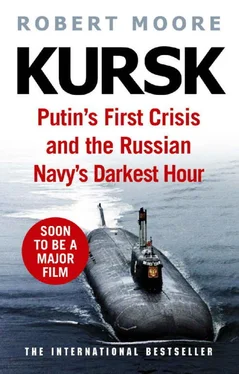Although we know the horrifying circumstances of the death of the twenty-three men in the aft compartments, it is more difficult to establish with any precision when they were engulfed by the flash-fire. Kolesnikov’s third and final note had no time written next to it. Initially, Fleet commanders declared that the crew members in the aft had survived for between eighteen and twenty-four hours. This timeline was politically convenient, for it meant that no one would suggest that the bungled rescue operation had cost the lives of sailors. After all, not even a superbly executed search-and-rescue effort would have reached the ninth hatch on the first day. But the forensic evidence from the salvaged submarine is much more troubling. This suggests that Dmitri Kolesnikov and his colleagues were alive for several days, possibly until Wednesday or Thursday. The evidence includes the large number of oxygen regeneration canisters that had been opened and used up by the survivors, a quantity that suggests they lived well beyond the first day. Vice Admiral Vladislav Ilyin, who headed the Kursk incident cell, is now convinced the sailors in the aft survived for at least three full days. There is even an outside chance that they were alive when the indefatigable submersible pilot Captain Sholokhov manoeuvred Priz over the ninth escape hatch late on Thursday, 17 August. But by the weekend – when the Seaway Eagle and the Normand Pioneer specialists arrived on the scene, eight days after the accident – the twenty-three men were almost certainly dead.
The reason why the Russian rescue vehicles Priz and Bester were unable to secure a ‘seal’ over the ninth hatch is still hotly debated by both Russian and Western submersible specialists. Ultimately, this failure doomed the surviving crew members.
Russian experts, both officially and in private, speak of a ‘crack’ on the surface of the upper hatch that distorted the steel rim just enough to make a seal impossible. The huge shock waves in the forward end of the Kursk were certainly powerful enough to have caused damage all the way down the hull. But the Seaway Eagle divers, highly experienced in evaluating sub-sea damage, established beyond doubt that there were no distortions to the hatch itself, and the upper door swung open once the tide had equalized the pressure with the inside of the escape tower. There does, however, remain the possibility that there was some damage in what is known as the ‘cofferdam’ boundary, the mechanism that rings the hatch. If this boundary was twisted, Captain Sholokhov may have been correct to blame ‘distortions’ for his failure to establish a vacuum with the aft escape hatch.
Other possibilities that have been raised are a defect in the sealing ring on the submersibles themselves or an operator error by the pilots. Certainly neither Bester nor Priz was well maintained. As the vessels deteriorated, many of the most able rescue professionals left the Fleet out of despair at the lack of resources, wearied by the constant battles with Moscow to retain their tiny budget.
Several Western specialists, including some of those who worked aboard the Seaway Eagle , believe that the Kursk spent the first few days of the disaster at an acute angle. They suggest that her jagged bow was cutting into the seabed but that her dry aft compartments, possessing positive buoyancy, were high in the water, quite possibly only a few dozen metres below the surface. If this was the case, the body of the submarine would have been pivoting with the movement of the currents and the tide – ‘weather-vaning’, as salvage divers call it. Any attempt at sealing with the ninth hatch in these circumstances would have been extraordinarily difficult.
For all these technical challenges, the Kursk sailors’ fate was sealed by a rescue service that had been starved of resources. Furthermore, the Admirals and politicians in Moscow were so preoccupied with issues of national prestige and secrecy, and with salvaging their own careers, that the offers of help from overseas that may have saved the twenty-three sailors in the aft section were rebuffed.
Russian leaders had fallen into a trap created by ambition and pride. They had forgotten that the assets really worth fighting to save were not the secrets of the submarine, or their own reputations, but the young sailors themselves.
During the long summer days of August 2017, seventeen years after the loss of the Kursk , the refurbished Russian rescue submersible AS-34 was lowered into deep waters off the coast of Norway, between the North Cape and Bear Island. The site was carefully chosen, lying close to where the Soviet experimental submarine Komsomolets sank after a fire in 1989. To this day, she lies on the seabed with a nuclear reactor and two nuclear warheads entombed in the wreckage. The location for the test dive was also along the route used by today’s Northern Fleet submarines as they head towards the North Atlantic for their covert patrols. After a two-year upgrade, the rescue system that failed so dismally over the Kursk was ready for a new certification. This time the AS-34 operated flawlessly down to a depth of 1,000 metres, with batteries that now have an endurance of 120 hours. The Northern Fleet described the trial as a complete success.
Just a month after that Russian drill, it was the turn of nine NATO navies to test their improved rescue systems. The Western rehearsal for saving trapped submariners was held in warmer waters along the coast of Marmaris, near Turkey’s Aksaz Naval Base. Exercise Dynamic Monarch took place in September 2017 with the aim of improving coordination and sharing technical knowledge between various specialist teams. The US Navy’s Undersea Rescue Command participated. It was also a rigorous test for the successor to the Royal Navy’s LR5 rescue submersible. The new package, known as NATO Submarine Rescue System (NSRS), is jointly owned and operated by the UK, France and Norway. It combines a Remotely Operated Vehicle that is designed to locate a submarine in distress and clear any debris, and a manned submersible that can connect with the submarine’s escape hatch and bring sailors to the surface. The whole system is compact enough to be quickly airlifted to any port in the world.
The improved technology and heightened awareness of the possibility of further submarine accidents raises interesting questions actively debated by the naval rescue community. If there is another Russian submarine disaster, would the admirals now accept help from their adversaries? Does Moscow privately accept that it was a blunder to reject Western help during the Kursk debacle? In all likelihood, even today, the Russian response would depend on the location, circumstances and secrecy of the submarine mission in question. It would almost certainly reignite the same debate and fissures within Russia’s military and political hierarchy. Some military leaders, imbued in the new nationalist tone of Russia, and ever suspicious of NATO motives, would still view a second disaster through the prism of pride and military secrecy. But many Admirals, who were in their formative years as young officers during the Kursk debacle, might today advocate for a joint Russian–Western rescue effort if it could save their sailors’ lives.
Encouragingly, in August 2005, there was an underwater accident in which British and American rescuers were rapidly deployed to help a small Russian submersible in distress. The AS-28 Priz, ironically itself an underwater rescue asset, became ensnared in cables off the coast of Kamchatka in the Pacific Ocean. Lying down in darkness to save battery power, and with ever-diminishing oxygen, the seven crew members could only wait for help. By day three, the Russian sailors were vomiting and rapidly weakening. A British Remotely Operated Vehicle eventually succeeded in cutting the cables and freeing the Russian submersible after seventy-two hours. As the seven sailors emerged and gulped the fresh Pacific air, British, US and Russian rescuers hugged each other. It had been an exceptionally narrow escape. Unspoken, but certainly in the minds of those at the scene, was the realization that twenty-three more lives might have been saved if the same spirit of collaboration had been embraced in the Barents Sea five years earlier.
Читать дальше












